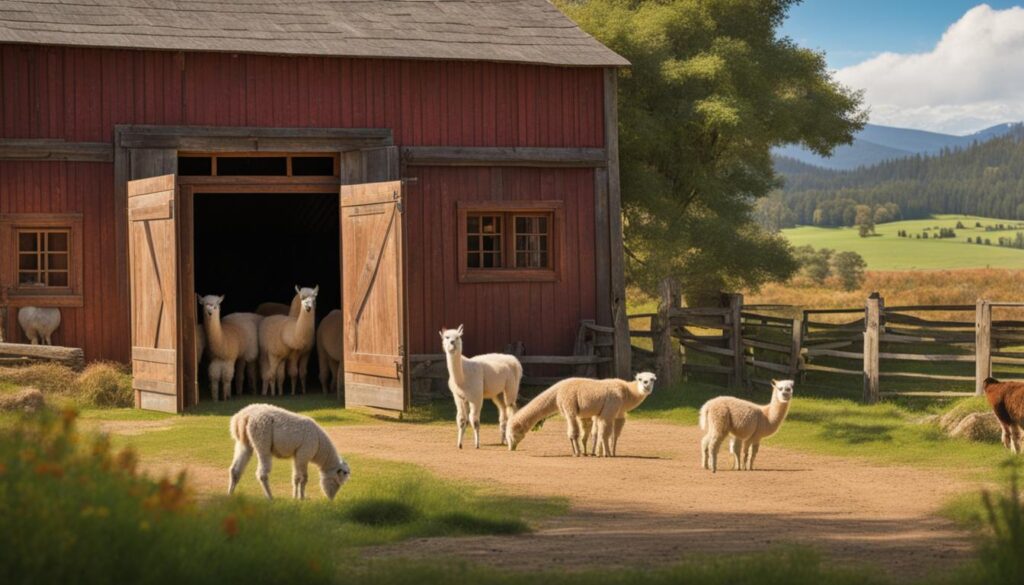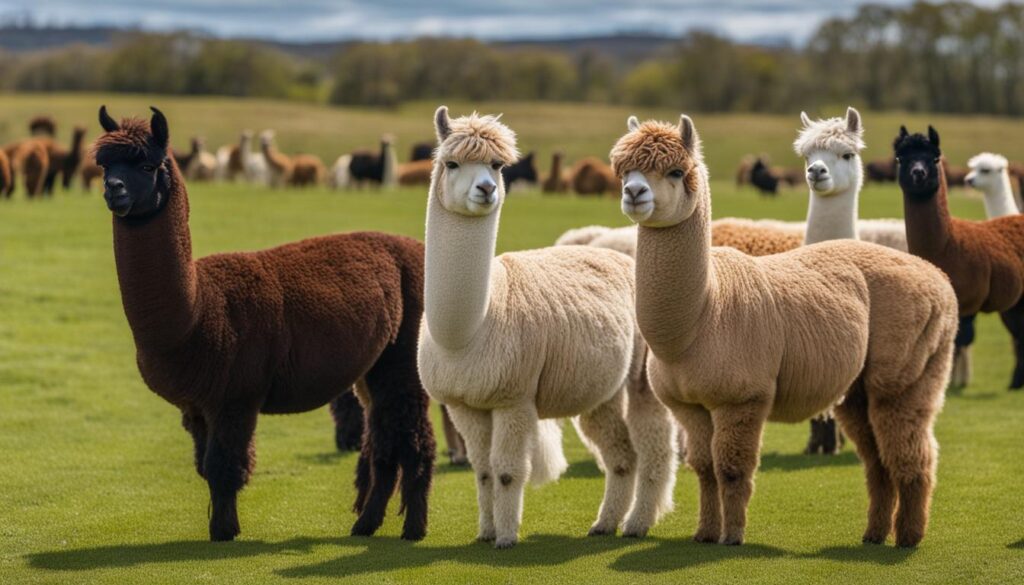Raising baby alpacas can be a rewarding venture, both personally and financially. As an alpaca enthusiast, I have discovered the joy of caring for these adorable animals and found ways to turn my passion into a profitable business. In this article, I will share with you the steps and considerations involved in raising baby alpacas and how you can make a profit from your alpaca farm.
When it comes to alpaca care, there are various aspects to consider, from providing a nurturing environment to ensuring their well-being and maximizing the value of their wool. By understanding the fundamentals of alpaca farming and utilizing effective breeding strategies, you can create a sustainable and profitable business in the alpaca industry.
Baby Alpacas: Key Takeaways:
- Baby alpacas can be a source of joy and profitability in your life.
- Understanding the fundamentals of alpaca care is essential for success.
- Implementing strategic breeding strategies can increase the value of your alpaca herd.
- Maximizing the value of alpaca wool through proper shearing and processing techniques can boost profitability.
- Participating in alpaca shows and networking with other breeders can create valuable marketing opportunities.
The Importance of Planning for Success
Success in any endeavor, including alpaca farming, requires careful planning. As an entrepreneur, I understand the significance of having a solid plan in place to ensure long-term success for your alpaca farm. By leveraging your knowledge and experience in small business startups, you can create a strategic plan that sets you up for success in the alpaca industry.
When it comes to planning for a successful alpaca farm, there are several key factors to consider:
- Competition: Research and analyze the competition in the alpaca farming industry. Understand their business models, target audience, and marketing strategies. This will help you identify opportunities to differentiate yourself and stand out in the market.
- Target Market: Define your target market and understand their preferences, needs, and purchasing behavior. This will enable you to tailor your products and marketing campaigns to attract and retain customers.
- Marketing Channels: Determine the most effective marketing channels to reach your target market. This could include online platforms, social media, local events, or collaborations with other businesses. By selecting the right marketing channels, you can maximize your reach and generate awareness for your alpaca farm.
- Execution: Develop a detailed plan for executing your strategies and achieving your business goals. Set clear objectives and establish milestones to track your progress. By monitoring and adjusting your plans as needed, you can ensure that you stay on track and adapt to market changes.
In conclusion, planning is a vital component of building a successful alpaca farm. By thoroughly researching and developing a strategic plan, you can position yourself for long-term success in the alpaca industry. Stay tuned for the next section, where we will explore the steps to start an alpaca farm.
Steps for Starting an Alpaca Farm
Before embarking on your alpaca farming journey, it’s important to lay a sturdy foundation for success. The following steps will guide you through the process, ensuring you’re fully equipped to establish and grow your alpaca farm.
1. Visit Local Alpaca Farms and Attend Alpaca Shows
Gaining firsthand knowledge and insights from experienced alpaca farmers is invaluable. Take the time to visit local alpaca farms and attend alpaca shows. This hands-on experience will provide you with a deeper understanding of alpaca care, breeding practices, and farm management techniques.
2. Research Farm Zoning and Regulations
Familiarize yourself with your local zoning laws and regulations pertaining to agricultural activities. Understanding the specific requirements for alpaca farms will help you navigate potential roadblocks and ensure compliance with any necessary permits or licenses.
3. Consult with an Accountant or CPA
Consulting with an accountant or CPA who specializes in agricultural businesses is crucial for understanding farm tax deductions and the potential financial benefits available to you. They can guide you on the best practices to maximize your tax advantages and streamline record-keeping processes.
4. Develop a Comprehensive Business Plan
A well-crafted business plan provides a roadmap for your alpaca farm’s success. Outline your goals, objectives, and strategies for marketing and growth. Include financial projections, an analysis of the market and competition, and contingency plans for potential challenges. A business plan will not only guide your decisions but also prove essential when seeking funding or partnerships.
| Benefits of a Comprehensive Business Plan | |
|---|---|
| 1. Provides a roadmap for your alpaca farm’s development and growth. | |
| 2. Helps attract potential investors, lenders, or partners. | |
| 3. Guides marketing and branding strategies. | |
| 4. Assists in financial planning and forecasting. | |
| 5. Identifies potential risks and challenges, allowing for preventive measures. | |
| 6. Provides clarity on your target market and competitive advantages. | |
| 7. Serves as a benchmark for monitoring progress and making adjustments. |
5. Secure Financing and Resources
Assess your financial needs and explore various financing options available for starting your alpaca farm. Whether through personal savings, business loans, or grants, ensure you have the necessary capital to cover initial expenses such as land acquisition, infrastructure setup, and purchasing alpacas. Additionally, gather essential resources such as veterinary contacts, alpaca suppliers, and equipment providers to support your farm’s operations.
“A well-crafted business plan provides a roadmap for your alpaca farm’s success.”
By following these steps, you’ll be well-prepared to embark on your alpaca farming journey. Establishing meaningful connections within the alpaca community, understanding local regulations, developing a solid business plan, and securing necessary financing and resources will set the stage for a thriving and prosperous alpaca farm.
Choosing the Right Name and Legal Structure
When starting your alpaca farm, it’s important to choose an appealing and distinctive farm name that reflects your brand. Make sure to research if the name is already in use to avoid any conflicts or confusion. A unique and memorable farm name can leave a lasting impression on potential customers and set your business apart.
Additionally, establishing the right legal structure for your farm is crucial for protecting your assets and ensuring compliance with regulations. Registering your farm as a Limited Liability Company (LLC) can provide personal liability protection and simplify the management of your business.
To get your alpaca farm up and running, you’ll need to obtain a few essential documents. Firstly, a federal tax ID (EIN) is necessary for tax filing and business banking purposes. This identification number ensures that your business is recognized by the IRS and facilitates smooth financial operations.
Moreover, obtaining a sales tax license is important if you plan to sell alpaca products. This license enables you to collect and remit sales tax on your sales, ensuring compliance with local tax regulations.
Managing legal paperwork can be overwhelming, but working with a registered agent can simplify the process. A registered agent can handle important correspondence and ensure that you meet all necessary requirements for your alpaca farm.
“Choosing a catchy and unique farm name is your first step towards building a strong brand identity for your alpaca farm. Once you have a name that captures your farm’s essence, it’s time to establish the right legal structure and gather the necessary documents to operate your business smoothly.”
Essential Documents for Your Alpaca Farm
| Document | Purpose |
|---|---|
| Farm Name | Reflects your brand and differentiates your business |
| LLC Registration | Offers liability protection and simplifies management |
| Federal Tax ID (EIN) | Facilitates tax filing and business banking |
| Sales Tax License | Enables collection and remittance of sales tax |
Setting Up Infrastructure for Alpacas

Alpacas require a suitable and comfortable living environment to thrive. To ensure their well-being, it is important to provide them with a barn or shelter that offers protection from extreme weather conditions.
“A well-built barn or shelter will keep your alpacas safe and cozy, shielding them from harsh winds, heavy rains, and intense heat.”
In addition to a snug shelter, appropriate fencing is crucial in keeping alpacas safe from local predators. Whether it’s coyotes, dogs, or other potential threats, sturdy fencing acts as a barrier, preventing predators from reaching the alpacas.
“Choosing the right fencing material and ensuring it is properly installed will safeguard your alpacas from dangerous encounters with predators.”
When setting up infrastructure for alpacas, it is essential to gather the necessary supplies to meet their basic needs. This includes water buckets, feeding bins, and halters, among other alpaca supplies. These items will contribute to their comfort and well-being, making their daily care more convenient for you.
Supplies Checklist for Alpacas:
| Item | Quantity |
|---|---|
| Water buckets | 4 |
| Feeding bins | 4 |
| Halters | 2 |
| Buckets for feed storage | 2 |
| Brooms for cleaning | 1 |
| Hay racks | 2 |
By providing a comfortable living environment, addressing predator concerns, and gathering essential supplies, you can ensure the well-being of your alpacas and create a nurturing space for their growth and development.
Finding and Selecting Alpacas for Your Farm

When starting your alpaca farm, finding and selecting the right alpacas is crucial for your success. The quality, health, and genetic traits of your alpacas will ultimately determine the value of your herd. Follow these steps to ensure you make the best choices for your farm:
- Research alpacas for sale from reputable breeders.
- Qualify the owners and their farms:
- Ask for references and visit their farms to assess their reputation and animal care practices.
- Ensure the breeder adheres to ethical breeding practices and prioritizes the health and well-being of their alpacas.
- Consider the following factors when evaluating alpacas:
- Alpaca quality: Look for alpacas with excellent conformation, dense and soft fleece, and good overall health.
- Breeding history: Review the pedigree and breeding records of the alpacas to assess their genetic potential.
- Genetic traits: Determine the traits you desire in your alpacas, whether it’s color, fleece quality, or specific characteristics.
I always advise aspiring alpaca farmers to prioritize quality over quantity. Investing in high-quality alpacas from reputable breeders will help you build a strong and valuable herd that can generate substantial returns.
By carefully selecting your alpacas based on reputable sources, breeding history, and desired traits, you can lay the foundation for a successful and thriving alpaca farm.
Factors to Consider When Selecting Alpacas
| Factor | Description |
|---|---|
| Alpaca Quality | Look for alpacas with excellent conformation, dense and soft fleece, and good overall health. |
| Breeding History | Review the pedigree and breeding records of the alpacas to assess their genetic potential. |
| Genetic Traits | Determine the traits you desire in your alpacas, whether it’s color, fleece quality, or specific characteristics. |
Breeding Strategies for Profitability
When it comes to breeding alpacas for profit, there are two main strategies that you can consider: breeding for quantity and breeding for quality. Each approach has its own advantages and considerations, and understanding them will help you maximize profitability in your alpaca farming business.
Breeding for Quantity
If you choose to focus on breeding for quantity, your primary goal is to produce a large number of alpacas. This strategy emphasizes maximizing fiber production, which can be a lucrative aspect of the alpaca industry. By carefully selecting breeding pairs with high-quality fleece and ensuring optimal breeding conditions, you can increase the number of alpacas in your herd and, consequently, the amount of valuable fiber you can harvest.
Breeding for quantity requires a meticulous approach to breeding management and herd expansion. It is essential to consider factors such as gestation periods, fertility rates, and genetic diversity to maintain the health and productivity of your herd. Additionally, providing proper nutrition and healthcare to your alpacas is crucial for their overall well-being and fiber production.
Breeding for Quality
On the other hand, breeding for quality focuses on starting with high-quality alpacas to produce offspring that exhibit desirable traits. This strategy encompasses various aspects, including fleece quality, teeth structure, bone density, and color. By selectively breeding alpacas with exceptional traits, you can create a herd that consistently yields superior offspring.
Color focus is a significant consideration when breeding for quality. Alpacas come in a wide range of colors, from subtle neutrals to vibrant shades. Some breeders specialize in breeding alpacas with specific colors that are in high demand in the market. By carefully selecting breeding pairs with desired color genetics and employing proper breeding techniques, you can cultivate a herd that produces alpacas in targeted colors, catering to the preferences of your customers.
To ensure breeding success, it is crucial to research and understand the genetic traits and inheritance patterns associated with desirable characteristics. This knowledge will enable you to make informed breeding decisions and consistently improve the quality of your alpaca herd over time.
Determining your breeding goals is a crucial step in both breeding strategies. Whether you choose to focus on quantity or quality, having a clear vision and specific traits in mind will help guide your breeding decisions and maximize profitability. Remember that breeding strategies should align with your overall business objectives and target market demands.
Ultimately, successful alpaca breeding relies on a combination of careful planning, genetic selection, and proper animal husbandry. By implementing the breeding strategy that aligns with your business goals and focusing on specific traits such as maximizing fiber production or color focus, you can position yourself for profitability in the alpaca farming industry.
Participating in Alpaca Shows and Networking
Participating in alpaca shows is not only an exciting opportunity for alpaca owners like me but also a valuable platform for networking and marketing our alpacas. These shows, especially those organized by the Alpaca Owners Association (AOA), are the perfect avenue to showcase our alpacas, connect with fellow breeders, engage potential buyers, and establish ourselves as reputable alpaca farms in the industry.
The Alpaca Owners Association (AOA) plays a crucial role in organizing alpaca shows and ensuring their success. As a member of the AOA, I have access to a wide range of show opportunities throughout the year. This membership provides me with a competitive advantage by allowing me to participate in highly regarded shows that attract both national and international audiences. By leveraging the AOA show system, I can significantly increase my chances of selling alpacas and building a thriving and successful business.
Participating in alpaca shows offers numerous benefits beyond merely showcasing our alpacas. It allows us to network with fellow breeders, exchange knowledge, and learn from each other’s experiences. These interactions can be invaluable, especially for newcomers to the industry like myself, as they provide opportunities to gather insights, gain new perspectives, and establish meaningful connections within the alpaca community.
Attending alpaca shows has been a game-changer for my business. The networking opportunities alone have opened doors to new partnerships and collaborations. I’ve met breeders who have become valuable mentors, guiding me through the intricacies of the industry. Moreover, showcasing my alpacas at these shows has significantly increased the visibility and credibility of my farm.
Networking at alpaca shows also presents a chance to connect with potential buyers. These events attract a diverse audience of alpaca enthusiasts, fiber artists, and individuals interested in starting their own alpaca farms. By engaging with these individuals, I can develop leads for future sales and expand my customer base. Additionally, participating in alpaca shows enables me to establish my reputation as a trusted source of high-quality alpacas. This reputation fosters customer loyalty and word-of-mouth marketing, both of which are crucial for sustained business growth.
In summary, participating in alpaca shows, particularly those coordinated by the Alpaca Owners Association (AOA), is a strategic move for alpaca owners looking to maximize their networking and marketing efforts. These shows provide us with a platform to showcase our alpacas, network with fellow breeders and potential buyers, and build a reputable brand in the industry. Through the AOA show system, we can amplify our chances of success in selling alpacas and establishing a thriving business.
Key Benefits of Participating in Alpaca Shows and Networking
| Benefits | Explanation |
|---|---|
| Showcasing alpacas | Opportunity to display the quality, beauty, and unique characteristics of our alpacas to a diverse audience. |
| Networking with fellow breeders | Chance to connect, learn from, and establish valuable relationships with experienced alpaca breeders. |
| Engaging potential buyers | Opportunity to interact with alpaca enthusiasts, fiber artists, and prospective alpaca farm owners, generating leads for sales. |
| Establishing reputation | Platform to build credibility and a trusted brand in the industry, fostering customer loyalty and word-of-mouth marketing. |
Conclusion
In conclusion, alpaca farming presents a wonderful opportunity for both personal fulfillment and financial success. By following the steps outlined in this article, you can embark on the journey of raising baby alpacas and turn it into a profitable venture. Remember, proper planning and strategic decision-making are key to establishing a successful alpaca farm.
With a focus on quality and a commitment to nurturing these adorable creatures, you can not only create high-quality alpaca products but also generate a steady income. Alpaca farming is more than just a hobby; it is an opportunity to build a thriving business in the alpaca industry.
So, whether you’re a seasoned entrepreneur or a newcomer to the business world, take the first step and start your alpaca farm. By investing in the right infrastructure, selecting the best alpacas, and participating in shows and networking events, you can make your mark in the alpaca industry and reap the rewards of your hard work and dedication.
FAQs
How long is the gestation period for alpacas?
The gestation period for alpacas is approximately 11 months.
How much milk do baby alpacas need?
Baby alpacas, also known as crias, need to nurse frequently and require approximately 10% of their body weight in milk per day.
How often do baby alpacas need to be fed?
Baby alpacas should be fed every 2-3 hours for the first few weeks of life. After that, they can be fed every 4-6 hours.
What should I feed my baby alpaca?
Baby alpacas should be fed their mother’s milk for the first 6 months of life. After that, they can be gradually weaned onto hay and pellets.
When should I start weaning my baby alpaca?
You can start weaning your baby alpaca at around 6 months of age. Begin by offering hay and pellets in addition to their mother’s milk.
How much should I feed my baby alpaca?
Baby alpacas should be fed approximately 10% of their body weight in milk per day. After weaning, they should be fed hay and pellets.
How do I care for a newborn baby alpaca?
Newborn baby alpacas need to be kept warm and dry. They should be fed frequently and monitored closely for any signs of illness.
When should I start training my baby alpaca?
You can start training your baby alpaca as early as 2-3 months of age. Begin with basic halter training and gradually introduce them to other training exercises.
How do I socialize my baby alpaca?
Socializing your baby alpaca is important for their development. You can introduce them to other alpacas and people at a young age to help them become comfortable with social interactions.
How do I keep my baby alpaca healthy?
To keep your baby alpaca healthy, you need to provide them with a clean and dry environment, a balanced diet, and plenty of exercise. You should also monitor them closely for any signs of illness and seek veterinary care if necessary.
How do I prevent illness in my baby alpaca?
Preventing illness in your baby alpaca involves providing them with a clean and dry environment, a balanced diet, and plenty of exercise. You should also monitor them closely for any signs of illness and seek veterinary care if necessary.
How do I treat illness in my baby alpaca?
If your baby alpaca becomes ill, you should seek veterinary care immediately. Treatment will depend on the specific illness and may involve medication, fluids, or other interventions.
How do I train my baby alpaca to walk on a lead?
To train your baby alpaca to walk on a lead, begin by introducing them to a halter. Gradually increase the amount of time they spend wearing the halter and practice leading them around your property.
How do I train my baby alpaca to be halter-broken?
To train your baby alpaca to be halter-broken, begin by introducing them to a halter. Gradually increase the amount of time they spend wearing the halter and practice leading them around your property.
How do I train my baby alpaca to be friendly?
To train your baby alpaca to be friendly, you need to socialize them from a young age. Introduce them to other alpacas and people and provide them with plenty of positive reinforcement.
How do I introduce my baby alpaca to other alpacas?
To introduce your baby alpaca to other alpacas, begin by allowing them to interact through a fence. Gradually increase the amount of time they spend together and monitor their behavior closely.
How do I introduce my baby alpaca to other animals?
To introduce your baby alpaca to other animals, begin by allowing them to interact through a fence. Gradually increase the amount of time they spend together and monitor their behavior closely.
How do I transport my baby alpaca?
To transport your baby alpaca, you should use a trailer or other suitable vehicle. Make sure that the trailer is clean and dry and that your baby alpaca has plenty of space to move around.
How do I prepare for the arrival of my baby alpaca?
To prepare for the arrival of your baby alpaca, you need to have a clean and dry environment ready for them. You should also have a supply of hay, pellets, and fresh water available. Make sure that the area where the baby alpaca will be kept is free from hazards such as sharp objects, poisonous plants, and other potential dangers. You should also have a plan in place for feeding and caring for the baby alpaca, including any necessary veterinary care.
It’s important to note that baby alpacas are sensitive to cold temperatures and need to be kept warm. You should provide them with a heat lamp or other source of warmth to keep them comfortable. Additionally, you should monitor the baby alpaca closely for any signs of illness or distress and seek veterinary care if necessary.
References
- The British Alpaca Society – This is a membership society dedicated to the welfare of alpacas and the education of their owners in the UK. The society provides information, support, and events for alpaca owners, breeders, and all those interested in alpacas. You can visit their website at bas-uk.com.
- Alpaca Owners Association, Inc. – This organization provides information on alpaca farms, alpacas for sale, alpaca shows and events, and education. You can visit their website at alpacainfo.com.
- Asociación Internacional de la Alpaca (AIA) – This organization aims to protect the image of alpaca fiber and products made with it while promoting its worldwide use and quality through sustainable growth. You can visit their website at aia.org.pe
Please also check out other articles on the website like:
Siberian Husky 101: A Comprehensive Guide for First-Time Owners
The Ultimate Tibetan Mastiff Dog: History, Characteristics, and Care Tips (2023-24)
Papillon Dog: Everything You Must Know Before You Own One (2023-24)
The Ultimate Tibetan Mastiff Dog: History, Characteristics, and Care Tips (2023-24)
The Catahoula Leopard Dog: A Ultimate Guide 2023 – 24.
Maremma Sheepdog: A Loyal and Fearless Guardian of Livestock 2023
The Mighty Kangal Shepherd Dog: History, Characteristics and Care Guide.
Portuguese Water Dog: The Ultimate Guide to its History, Characteristics, and Care (2023)
10 Dogs Who Are Born to Be Working Dogs
Labrador Retriever vs. Golden Retriever: Which Breed Is Right for You in 2023?
10 Best Dogs Who Are Surprisingly Good Swimmers
The Top 10 Most Popular Dog Breeds in America
A Comprehensive Guide to Havanese Dogs 2023: History, Characteristics, Care, and Training
Toy Dog Breeds: Small Dogs with Big Personalities
Top 25 Medium Size Dog Breeds for First Time Owners
The Essential Guide to Newfoundland Dogs 2023
A Comprehensive Guide to the Most Popular Hunting Dog Breeds
A Comprehensive Guide to the Dogo Argentino – Everything You Need to Know
Top 10 Rare Dog Breeds: The Hidden Gems of the Canine World
15 Most Expensive Dog Breeds: A Comprehensive Guide
Bernese Mountain Dog:10 Surprising Facts That You May Not Have Known.
Bengal Cats – A Complete Guide to Understanding and Caring for These Magnificent Felines
Persian Cat: Your Ultimate Guide to This Regal Breed
Discover the Unique Charm of the Sphynx Cat Breed (2023-24)
The Ultimate Guide to Aardvarks: Everything You Need to Know!



